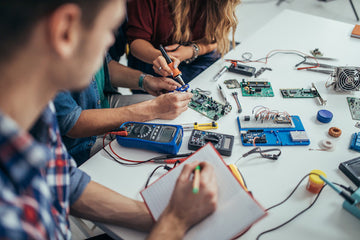
The ubiquitous nature of electricity sometimes causes people to neglect electrical safety hazards. People are so used to instant, safe access to electricity they forget just how powerful electrical energy is. 2018 saw 1,560 nonfatal electrical injuries and 180 electrical fatalities. 54 percent of fatalities occurred in the construction industry, but the risk of an electrical hazard can occur in any workplace environment, from an office to a manufacturing floor.
The Effects of Electrical Hazards
The human body conducts electricity. Should an employee come into contact with an electrical current, current flows through the body, damaging tissue and causing intense pain, burns, and shock. Burns can also occur due to contact with the high temperatures caused by electrical arcs, or from touching overheated electrical components.
Electrocution can stop the heart with currents as low as 30 mA AC or 300-500 mA DC, especially if the electrical flow passed through the heart or brain. The risk of electrocution increases when working with faulty equipment, open electrical circuits, live wires, or operating electrical equipment in wet conditions.
Electrical Hazard Engineering Solutions
A number of precautionary steps can be taken to reduce or eliminate electrical safety hazards, including:
- Insulation to stop or reduce the flow of electrical current. Insulation must be capable of handling the amount of voltage used. While highly effective when used properly, insulation can fail when exposed to extreme temperatures or contact with gasoline or other corrosive substances.
- Guarding encloses electrical safety hazards to prevent contact. All guarding must include clear warning signs. Guarding for 50 volts or more should be isolated so only authorized workers with electrical hazard training can access and operate the equipment.
- Grounding gives an electrical system a low-resistance path connecting to the earth to prevent voltage from building up. Grounding is considered secondary protection, as it reduces but does not eliminate the risks posed by an electrical hazard.
- Circuit Protection Devices stop or limit electrical flow in the event of an overload, short circuit, or ground fault. Fuses, circuit breakers, ground-fault circuit interrupters, and arc-fault circuit interrupters all fall into this category.
Safe Work Practices
Proper electrical hazard training reduces the likelihood of electrical injuries. Maintenance staff and employees operating electrical machinery should receive certified arc flash safety training. Employees should understand the importance of de-energizing electrical equipment before, repairs, or inspections--and how to safely de-energize equipment. Electrical tools should be well-maintained and replaced as needed, and workers should have access to appropriate PPE and understand how to use it.
Employees should be trained to exercise caution when working near energized lines, and when working outside should maintain a minimum distance of 10 feet from overhead power lines.
Large electrical equipment isn’t the only source of electrical hazards--overloaded power outlets, misused extension cords, and damaged electrical components can affect any workplace--including office environments. To increase electrical safety in the workplace, employees should understand and apply the following electrical safety tips:
- Always unplug or disconnect machines before servicing or repair.
- Any equipment that feels hot, smokes, sparks, or makes unusual noises (buzzing or humming) should be taken out of service immediately.
- Avoid plugging two extension cords together.
- Avoid using extension cords whenever possible.
- Cover or guard exposed electrical components, and use warning labels to alert employees to the electrical hazard.
- Do not overload outlets.
- Do not plug multi-use power bars to each other.
- Do not run cords down hallways or aisles to prevent tripping.
- Do not use electrical equipment when hands or equipment is wet.
- Do not use electrical equipment on wet surfaces.
- Inspect cords and equipment regularly, replacing any with signs of damage. Do not attempt to fix any frayed cord with electricians tape.
- Never cover cords with rugs or mats, which can damage cords and create tripping hazards.
- Only use equipment approved by a national testing laboratory.
- Only use properly grounded or double -insulated equipment.
- Unplug cords from outlets by gripping the plug, not the cord.
Electrical Hazard Training
Training and awareness are the best way to protect employees from electrical safety hazards. Depending on the nature of your work environment, this may mean a basic electrical safety course, a more involved course like arc flash electrical safety, or industry-specific training such as electrical safety in the laboratory or electrical safety in HAZMAT environments. All types of electrical hazard training have the same goal--to make your workplace safer









Comments
Sorry, no comments found for this article